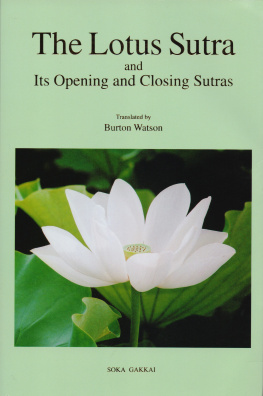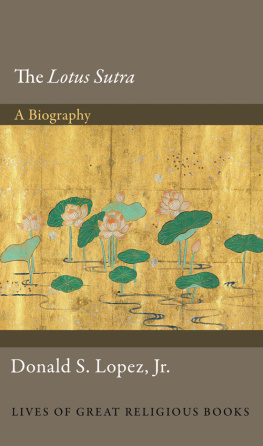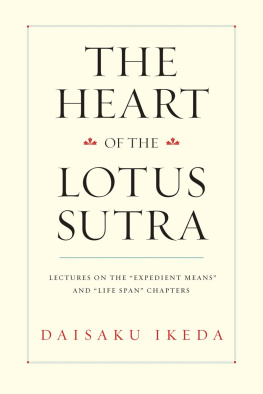I NTRODUCTION
TO THE L OTUS S UTRA

Soon after entering university in December of 1943, I was sent to the front as a student soldier. I wondered if I were allowed to bring but a single book on the trip, possibly to my death, which would I want to bring. It was the Lotus Sutra.
from the authors preface
The Lotus Sutraone of the most popular Buddhist classicsis here accessibly introduced by one of its most eminent scholars.
H aving developed a lifelong appreciation of the Lotus Sutra, Yoshiro Tamura sought to author an introduction to this beloved work of Buddhist literature. Tamura wanted it to be different than other basic explorations of the textplain-spoken, relevant and sensitive to modern concerns, and well-informed by contemporary scholar-ship. Introduction to the Lotus Sutra grounds this ancient work of literature in the real, worka-day world, revealing its continued appeal across the ages.
Learned yet accessible, this Introduction to the Lotus Sutra provides an elegant historical, textual, and philosophical overview of key aspects of the background and translation of what is arguably the most widely disseminated scripture of Mahayana Buddhism and of the lived communities that developed around it.
Mark Unno, editor of Buddhism and Psychotherapy across Cultures
Tamura offers a gentle and reflective introduction to the history of Buddhism, the substance of the Lotus, and the roles of its followers. His teaching nourishes us like the single flavor of the rain falling on all living beings.
Franz Metcalf, author of Being Buddha at Work
YOSHIRO TAMURA (192189) was a well-regarded scholar of Japanese Buddhism, known particularly for his study of the Lotus Sutra and the traditions that developed around it and the person of Nichiren in Japan.
GENE REEVES is a Buddhist scholar and teacher, process philosopher, and theologian. He is the translator of The Lotus Sutra and the author of The Stories of the Lotus Sutra. Reeves lives in Tokyo and Chicago.
Contents
Publishers Acknowledgment
THE PUBLISHER gratefully acknowledges the generous contribution of the Hershey Family Foundation toward the publication of this book.
I NTRODUCTION
TO THE L OTUS S UTRA
O N A VISIT to Japan in the autumn of 1983, I had the good fortune of being introduced to Yoshiro Tamura (192189) through arrangements made by Nikkyo Niwano, the founder and then president of Rissho Kosei-kai. Soon we were able to arrange for Prof. Tamura to come to Chicago the following spring to give a series of lectures on the Lotus Sutra at Meadville Lombard Theological School at the University of Chicago. Since those lectures were very well received, Tamura was invited back to the University of Chicago as Numata Professor in the spring of 1985. During subsequent years I met Tamura many times, both in Chicago and in Japan. He was a key member in a series of small conferences that I had organized in Chicago and in Japan. It was partly on account of Tamuras encouragement that my own interest in the Lotus Sutra grew enormously during that time. Together, Tamura and I cooked up a few projects related to the Lotus Sutra, which led to my eventual move to Japan in January of 1989, in part to work with and to continue to learn from him.
Unfortunately, our collaboration was not to be realized. Just before I left Chicago to go to Japan, Tamura was diagnosed with liver cancer. He passed away less than three months later. It was shortly after this that Michio Shinozaki, then Dean of Rissho Kosei-kais Gakurin Seminary, and I committed ourselves to translating Tamuras small introduction to the Lotus Sutra, The Lotus Sutra: Truth Life Practice.
Tamura was not a popular writer. When we met he was a professor at Rissho University, Nichiren-shus university in Tokyo. This followed his retirement from the University of Tokyo in 1982, where he held the chair in Japanese Buddhism. He was an academic and a historian. Yet he also had a kind of laymans love of the Lotus Sutra, which is reflected in his preface to this book. He knew as well as anyone that the Lotus Sutra was not merely something fit for academic scrutiny, but a religious text very much alive in the contemporary world.
His small book, first published in Japan in 1969, was intended for a popular audience. It introduces the teachings of the Lotus Sutra, some of the scholarly work on its composition, and the role it has had in East Asian, especially Japanese, history. Part of a popular but sophisticated series, the book was intended to inform educated, nonspecialist Japanese readers about the Lotus Sutra and its uses and evaluations in history. Since the Lotus Sutra is the primary Buddhist text for several traditional Japanese Buddhist denominations of the Nichiren and Tendai traditions, as well as for several new Buddhist organizations that emerged in the twentieth century, particularly for the Reiyukai, Rissho Kosei-kai, and Soka Gakkai, the number of potential readers in contemporary Japan would have been very substantial. Well over twenty million Japanese recite regularly from the Lotus Sutra.
So the audience Tamura intended for his book was not made up of his fellow academicsat least not primarilybut of serious lay Buddhists who already had some familiarity with the Lotus Sutra. Of course, we cannot assume as much familiarity with the Lotus Sutra on the part of an English reading audience. But with the growing popularity of many varieties of Buddhism in the United States and Europe, the number of people in those lands that know of the Lotus Sutra can be presumed to be growing, too. We hope that this revision and translation of Tamuras introduction to the Lotus Sutra will deepen for many their understanding of the Sutra, and broaden their understanding and appreciation of Buddhism in general by historically situating the Sutra and surveying its contributions to the development of East Asian Buddhist thought.
Tamura was raised in a Christian family, but he soon grew dissatisfied with Christianity for a variety of reasons and did not maintain any affiliation with the church as an adult. While it would be fair, I think, to say that he was deeply impressed by teachings of the Lotus Sutra and enjoyed friendly relations with several Buddhist organizations, including the traditional Nichiren-shu and the modern Rissho Kosei-kai, so far as I know, he never became a practicing member of any religious organization. Like many of his academic colleagues, Tamura was religiously unaffiliated.
In Japan and among students of Japanese Buddhism, Tamura is most
Some might think that the section of this book dealing with Tendai thought should be updated somehow to reflect how Tamura would have responded to recent critiques of Tendai original enlightenment thought. In fact, we can only speculate on how Tamura might have responded to such developments. My own guess is that he would have rejected any form of monistic ground, while supporting the affirmation of the reality of all things, a notion found both in the Lotus Sutra and some forms of Tendai original enlightenment thought. But, since this is simply speculation on my part, it would seem inappropriate to change Tamuras text to reflect developments of which he was not a part.
Though Tamura does discuss Tendai thought in this book, it is really about the Lotus Sutra, and very little of what is known about the Lotus Sutra has changed since Tamura wrote it. There are a variety of opinions on certain matters related to the history of the Sutra, such as why the Sanskrit originals of the Lotus from which Chinese translations were made have never been found, some of which differ from Tamuras view. But this would be true even if Tamura were writing the book today.
Next page







